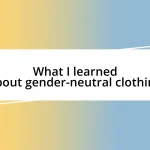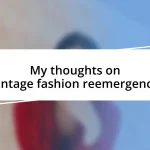Key takeaways:
- Realization of fast fashion’s environmental impact led to a deeper engagement with sustainable practices and community empowerment through local artisans.
- Key concepts of sustainable fashion include circular economy, ethical sourcing, slow fashion, and transparency, which redefine consumer relationships with clothing.
- Challenges such as fast fashion mindset, supply chain transparency, and the financial burden of sustainable products hinder broader acceptance of sustainable fashion principles.

Introduction to Sustainable Fashion Projects
Sustainable fashion projects are about redefining how we perceive and engage with clothing. Reflecting on my own experiences, I remember the first time I learned about the environmental impact of the fast fashion industry. It hit me hard—how often had I mindlessly bought trendy clothes, only to wear them a few times before they ended up in the back of my closet?
When I embarked on my journey into sustainable fashion, I was surprised by how much creativity and innovation flourished in this space. I stumbled upon a local initiative that upcycled discarded materials into beautiful garments. This experience opened my eyes to the potential of repurposing and finding beauty in what many consider waste. Isn’t it inspiring to think about how we can transform old materials into something new and meaningful?
Participating in sustainable fashion projects also deepened my understanding of community impact. I learned that local artisans often incorporate traditional techniques into their work, empowering them while preserving cultural heritage. Have you ever considered how fashion can connect us to wider social and ethical conversations? For me, this realization added an enriching layer to my relationship with clothing and its story.

Understanding Sustainable Fashion Concepts
Delving into sustainable fashion concepts, I quickly recognized it’s more than just eco-friendly practices—it’s a holistic approach to the lifecycle of clothing. For instance, when I participated in a workshop on circular fashion, I learned how essential it is to design garments with their end-of-life in mind. This shift in perspective was eye-opening, as it reminded me of the countless times I’ve discarded items without a second thought.
Here are some key concepts that I found crucial in understanding sustainable fashion:
- Circular Economy: Encouraging a system where products are reused, repaired, and recycled, creating a closed-loop system that minimizes waste.
- Ethical Sourcing: Prioritizing materials and labor practices that are fair, humane, and environmentally responsible.
- Slow Fashion: Emphasizing quality over quantity by encouraging thoughtful purchasing and timeless design, promoting a shift from fast consumerism.
- Transparency: Companies openly sharing their supply chains, production practices, and materials used, granting consumers insight into the environmental and social impact of their choices.
As I absorbed these concepts, my connection to my clothing deepened, transforming shopping into a more thoughtful experience. It’s fascinating how these principles can reshape not only our wardrobes but also our values and actions as conscious consumers.

Key Benefits of Sustainable Fashion
Sustainable fashion offers numerous benefits that resonate deeply with both consumers and the environment. One key advantage is the reduction of waste in landfills. I remember standing at a textile recycling facility and witnessing piles of discarded fabrics that could have been repurposed. It was a poignant moment; each item represented a missed opportunity for creativity and reuse in the industry.
Another important benefit lies in the promotion of fair labor practices. When I switched to shopping from sustainable brands, I felt a sense of pride knowing that my purchases supported workers who were compensated fairly. This shift transformed my shopping habits into a conscious decision-making process, and it made me appreciate the stories behind each garment, reinforcing a connection to the people who craft our clothing.
Lastly, sustainable fashion encourages innovative designs that prioritize longevity and versatility. I engaged in a project where we created multi-functional clothing that could be styled in different ways, allowing for reduced consumption. This experience highlighted how investing in quality pieces not only inverts the fast-fashion mindset but also supports a more sustainable wardrobe.
| Key Benefits | Description |
|---|---|
| Reduction of Waste | Minimizes landfill contributions by promoting reusing and recycling materials. |
| Fair Labor Practices | Supports ethical treatment of workers and fair wages within the fashion industry. |
| Innovative Designs | Encourages multifunctional products, transforming how we view and use clothing. |

Challenges in Sustainable Fashion Initiatives
One of the significant challenges I’ve encountered in sustainable fashion initiatives is the prevailing mindset around fast fashion. Often, I find myself explaining to friends why it’s essential to choose quality over quantity, but the instant gratification of inexpensive, trendy items can be hard to resist. Have you ever felt that tug when a new collection drops? That temptation can undermine the collective efforts towards creating a more sustainable fashion landscape.
Supply chain transparency is another hurdle that really struck a chord with me. During my work with a small sustainable brand, I discovered how complex and, at times, murky sourcing practices can be. There’s a certain frustration that comes with wanting to make ethical choices but not having clear information on a brand’s origins or production methods. It makes you wonder: How can we trust the brands we support when their stories often remain hidden behind layers of marketing?
Moreover, the financial aspect can’t be overlooked. I remember struggling with the higher price tags associated with sustainable products. While I understand the importance of investing in ethical clothing, I often questioned whether my budget could accommodate such a shift. This tension between supporting sustainable practices and managing personal finances can leave many feeling stuck—have you ever faced that dilemma? It’s a nuanced challenge that invites a broader conversation about how we can restructure our spending to prioritize sustainability.

Innovative Strategies for Sustainable Projects
When it comes to innovative strategies in sustainable fashion projects, collaboration often stands out as a game changer. I recall working on a partnership between local artisans and fashion designers. This fusion not only highlighted traditional techniques but also supported local economies. By blending different perspectives, we crafted pieces that told a richer story. Isn’t it incredible how collaboration can bring fresh ideas to the forefront while honoring timeless craftsmanship?
Experimentation with materials also plays a crucial role in pushing the boundaries of sustainable fashion. I remember participating in a workshop focused on upcycling, where we transformed discarded textiles into fashionable pieces. The thrill of seeing potential in what others deemed waste shifted my mindset entirely. It made me ponder: how many hidden treasures are in our closets just waiting for a creative touch? This approach not only reduces waste but sparks new avenues for design innovation.
Technology is rapidly reshaping the landscape of sustainable fashion. For instance, using 3D printing to create garments can drastically minimize material waste. I had the opportunity to observe a designer who utilized this method to produce clothing on demand. It was fascinating to see clothing being created only as needed—can you imagine a world where overproduction is a thing of the past? This shift toward precision and customization offers exciting prospects for a sustainable future.














